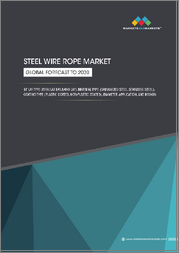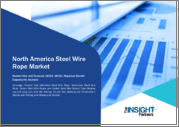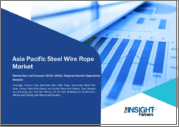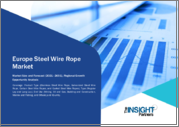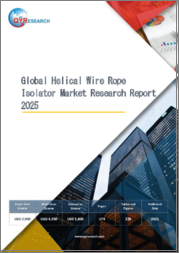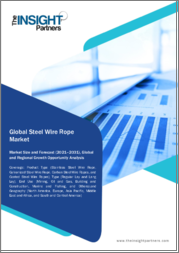
|
시장보고서
상품코드
1804776
와이어 로프 시장 : 재료, 코어, 꼬임 유형, 직경 범위, 스트랜드 패턴, 용도, 최종사용자 산업, 유통 채널별 - 세계 예측(2025-2030년)Wire Rope Market by Material, Core, Lay Type, Diameter Range, Strand Pattern, Application, End-User Industry, Distribution Channel - Global Forecast 2025-2030 |
||||||
와이어 로프 시장은 2024년에는 91억 5,000만 달러에 달하며, 2025년에는 CAGR 4.84%로 95억 7,000만 달러로 성장하며, 2030년에는 121억 5,000만 달러에 달할 것으로 예측됩니다.
| 주요 시장 통계 | |
|---|---|
| 기준연도 2024 | 91억 5,000만 달러 |
| 추정연도 2025 | 95억 7,000만 달러 |
| 예측연도 2030 | 121억 5,000만 달러 |
| CAGR(%) | 4.84% |
와이어 로프의 기능, 소재의 다양성, 세계 산업 사업 및 인프라 개발을 주도하는 전략적 중요성 심층 조사
와이어 로프는 전 세계의 중요한 산업 및 인프라 사업을 지원하는 필수적인 구성 요소로 남아 있습니다. 우뚝 솟은 건설 프로젝트부터 광산 및 해양 시추에 사용되는 복잡한 기계에 이르기까지 꼬인 가닥의 집합체인 와이어 로프는 기존 케이블에는 없는 인장 강도, 유연성 및 내구성을 제공합니다. 수십 년간의 기술 혁신 속에서 재료 과학자와 엔지니어들은 극한의 하중, 온도 및 부식 조건에서 성능을 최적화하기 위해 와이어 로프의 구성을 발전시켜 왔습니다. 오늘날 와이어 로프는 중량물 리프팅 용도뿐만 아니라 구조물 지지 시스템, 견인 작업, 중요한 제어 및 안전 메커니즘에서도 매우 중요한 역할을 하고 있습니다.
지속가능성, 디지털화, 첨단 소재 채택에 초점을 맞추고, 와이어 로프 산업을 형성하는 새로운 동향과 기술 혁신에 중점을 둡니다.
와이어 로프 산업은 기술 혁신, 환경 규제, 최종사용자의 기대치 변화로 인해 변화의 시기를 맞이하고 있습니다. 지속가능성에 대한 관심이 급증하면서 친환경 코팅과 재활용 소재에 대한 관심이 높아지고 있으며, 전 세계 규제기관은 제조시 배출가스 및 폐기물 관리에 대한 기준을 강화하는 추세입니다. 이와 병행하여 와이어 로프에 센서와 스마트 모니터링 시스템을 내장하는 것이 보편화되고 있으며, 장력, 피로, 마모에 대한 실시간 진단이 가능해졌습니다. 이러한 디지털 기술의 강화로 운영자는 예지보전 스케줄링, 다운타임 위험 감소, 서비스 수명 연장을 통해 기존의 유지보수 주기와 비용 구조를 재구성할 수 있게 되었습니다.
2025년 미국 관세 조정과 와이어 로프 공급망, 비용 구조, 전략적 조달 결정에 미치는 복합적 영향 분석
2025년 미국 관세 개정 조치의 도입은 와이어 로프 생태계 전체에 파급 효과를 가져왔습니다. 주요 부품, 특히 특수강종과 고성능 고분자 섬유에 대한 수입 관세는 세계 공급처에 의존하는 국내 제조업체의 상륙 비용을 상승시키고 있습니다. 그 결과, 조달팀은 공급업체와의 계약을 재검토하고, 원자재 대체 지역을 모색하고, 정책 변동에 대한 추가 헤지를 위해 장기 계약을 협상하고 있습니다. 이러한 전략적 재조정은 지정학적 영향과 무역 변동에 대한 노출을 줄이는 데 있으며, 공급망의 탄력성이 중요하다는 점을 강조하고 있습니다.
와이어 로프 시장의 종합적인 세분화 분석 : 재료, 코어, 레이 유형, 직경, 스트랜드 패턴, 애플리케이션, 최종사용자, 유통 인사이트
와이어 로프 시장은 다양한 재료 구성, 코어 구조, 레이 패턴, 직경 사양, 스트랜드 구성, 응용 시나리오, 최종사용자 산업, 유통 경로를 반영하는 계층적 부문 구조를 보여줍니다. 재료 수준에서는 폴리머와 강철 합금으로 나뉩니다. 폴리머 로프는 범용성이 높은 폴리에스테르, 내화학성이 높은 폴리프로필렌, 고강도 경량 초고분자량 폴리에틸렌 섬유를 사용합니다. 스틸 로프는 표준 하중 요건에 맞는 탄소강, 부식 방지에 최적화된 아연도금강, 열악한 환경 및 해양 환경에 맞게 설계된 스테인리스강 등이 있습니다.
와이어 로프 산업의 지역적 전망: 아메리카, 유럽, 중동 및 아프리카, 아시아태평양의 지역 역학, 수요 촉진요인, 무역 흐름, 성장 패턴을 밝힙니다.
와이어 로프 산업의 지역적 역학은 북미, 남미, 중동 및 아프리카, 아시아태평양별로 서로 다른 수요 동인, 규제 프레임워크 및 공급망 구조를 드러내고 있습니다. 북미와 남미에서는 탄탄한 인프라 투자, 광업 사업 확대, 석유 및 가스 투자 회복으로 중하중용 강선 로프에 대한 안정적인 수요가 촉진되고, 북미의 첨단 제조 기지가 정밀 폴리머 솔루션에 대한 수요를 증가시키고 있습니다. 이 지역내 국경 간 무역은 간소화된 세관 프로토콜과 주요 생산 기지와 최종 사용 시장을 연결하는 통합 운송 네트워크의 영향을 받고 있습니다.
혁신, 파트너십, 시장 포지셔닝 전략에 중점을 둔 주요 와이어 로프 제조업체의 전략적 프로파일 및 경쟁 분석
주요 와이어 로프 제조업체는 수직 통합, 연구 파트너십, 표적화된 인수를 결합하여 시장 지위를 강화하고 혁신 파이프라인을 가속화하고 있습니다. 주요 제조업체들은 특수 소재 공급업체와 공동 개발 계약을 체결하여 차세대 폴리머 및 첨단 철강 합금을 조기에 확보할 수 있도록 하고 있습니다. 동시에 자동화 생산 라인과 디지털 품질관리 시스템에 대한 전략적 투자로 처리 효율이 향상되고 불량률이 감소했습니다.
와이어 로프 사업에서 공급망 최적화, 기술 혁신 가속화, 지속가능성 강화를 위한 업계 리더를 위한 실행 가능한 전략적 제안
경쟁력을 유지하고 향상시키고자 하는 업계 리더들은 여러 조달 지역에 걸친 전략적 파트너십을 구축하고, 공급망 다각화를 우선시해야 합니다. 폴리머 공급업체와 철강 공급업체와의 관계를 강화함으로써 기업은 관세 변동과 원자재 부족에 대한 취약성을 줄일 수 있습니다. 동시에, 특히 고성능 폴리에틸렌 섬유 및 코팅강합금과 같은 첨단 소재 연구에 투자함으로써 부식 환경 및 고온 환경에서 새로운 용도를 개발할 수 있습니다.
와이어 로프 시장 조사를 지원하는 데이터 수집, 전문가별 컨설팅, 분석 프레임워크, 검증 프로세스를 상세하게 설명하는 엄격한 조사 기법
본 조사는 종합적인 2차 설문조사와 표적화된 1차 인터뷰, 면밀한 데이터 검증 프로토콜을 결합한 엄격한 조사 방식을 채택했습니다. 업계 잡지, 기술 표준 간행물, 기업 공시 등의 2차 정보원으로부터 재료 동향, 규제 변화, 경쟁사 포지셔닝에 대한 기초적인 인사이트을 얻었습니다. 이 기반을 강화하기 위해 여러 지역의 제조업체, 유통업체, 최종사용자, 주제별 전문가들과의 구조화된 인터뷰를 통해 1차 조사를 실시했습니다.
와이어 로프 시장 상황을 탐색하는 이해 관계자를 위한 주요 연구 결과, 전략적 과제, 미래 전망을 강조하는 결론적 인사이트
와이어 로프 시장은 기술 발전, 지속가능성의 필요성, 진화하는 거래 역학에 의해 정의되는 교차로에 서 있습니다. 고성능 소재를 채택하고, 디지털 모니터링에 투자하고, 관세 조정을 고려하여 공급망 전략을 조정하는 이해관계자는 지속적인 경쟁 우위를 확보할 수 있습니다. 동시에 애프터마켓 서비스와 데이터베이스 솔루션을 자사 제품에 통합하는 제조업체는 고객 충성도를 강화하고 새로운 매출 기회를 창출할 수 있을 것으로 보입니다.
목차
제1장 서문
제2장 조사 방법
제3장 개요
제4장 시장 개요
제5장 시장 역학
제6장 시장 인사이트
- Porter's Five Forces 분석
- PESTEL 분석
제7장 미국 관세의 누적 영향 2025
제8장 와이어 로프 시장 : 재료별
- 폴리머
- 폴리에스테르
- 폴리프로필렌
- 초고분자량 폴리에틸렌(UHMWPE)
- 강철
- 탄소강
- 아연도금강
- 스테인리스강
제9장 와이어 로프 시장 : 코어별
- 섬유 코어
- 독립 코어
- 와이어 코어
제10장 와이어 로프 시장 : 꼬임 유형별
- Alternate Lay
- Lang Lay
- Regular Lay
제11장 와이어 로프 시장 : 직경 범위별
- 대경(20mm 이상)
- 중경(6-20mm)
- 소경(6mm 미만)
제12장 와이어 로프 시장 : 스트랜드 패턴
- 조합
- 이중층
- 필러 와이어
- 실
- 워링턴
- 단층
제13장 와이어 로프 시장 : 용도별
- 제어와 안전
- 리프팅 & 호이스트
- 구조 지원
- 견인·운반
제14장 와이어 로프 시장 : 최종사용자 업계별
- 건설과 인프라
- 상업
- 산업
- 주택
- 제조업 및 산업 기기
- 해운
- 광업과 채석업
- 석유 및 가스 산업
- 운송기관
제15장 와이어 로프 시장 : 유통 채널별
- 오프라인 채널
- 직접 판매
- 판매 대리점
- 온라인 채널
제16장 아메리카의 와이어 로프 시장
- 미국
- 캐나다
- 멕시코
- 브라질
- 아르헨티나
제17장 유럽, 중동 및 아프리카의 와이어 로프 시장
- 영국
- 독일
- 프랑스
- 러시아
- 이탈리아
- 스페인
- 아랍에미리트
- 사우디아라비아
- 남아프리카공화국
- 덴마크
- 네덜란드
- 카타르
- 핀란드
- 스웨덴
- 나이지리아
- 이집트
- 튀르키예
- 이스라엘
- 노르웨이
- 폴란드
- 스위스
제18장 아시아태평양의 와이어 로프 시장
- 중국
- 인도
- 일본
- 호주
- 한국
- 인도네시아
- 태국
- 필리핀
- 말레이시아
- 싱가포르
- 베트남
- 대만
제19장 경쟁 구도
- 시장 점유율 분석, 2024
- FPNV 포지셔닝 매트릭스, 2024
- 경쟁 분석
- ArcelorMittal S.A.
- Wellworth Wire Ropes(P) Ltd.
- Bansal Group
- Bharat Wire Ropes Ltd.
- Brunton Shaw UK
- Carl Stahl Technocables GmbH
- CASAR
- DENWIRE ROPES
- Desh Wire Products Private Limited
- Fyns Kran Udstyr A/S
- Interflon
- Loos & Co. Inc.
- MEP Deck Solutions Pte Ltd.
- Mordec International Pte Ltd
- Nantong Guangming Steel Wire Products Co.Ltd
- PFEIFER Group
- S3i Group
- Shree Steel Wire Ropes Ltd.
- Sing Teck Leong
- Southwest Wire Rope
- SWR Ltd.
- TEHO Ropes & Supplies Pte. Ltd.
- TEUFELBERGER Holding Aktiengesellschaft
- Universal Enterprises
- Usha Martin Limited
제20장 리서치 AI
제21장 리서치 통계
제22장 리서치 컨택
제23장 리서치 기사
제24장 부록
KSA 25.09.17The Wire Rope Market was valued at USD 9.15 billion in 2024 and is projected to grow to USD 9.57 billion in 2025, with a CAGR of 4.84%, reaching USD 12.15 billion by 2030.
| KEY MARKET STATISTICS | |
|---|---|
| Base Year [2024] | USD 9.15 billion |
| Estimated Year [2025] | USD 9.57 billion |
| Forecast Year [2030] | USD 12.15 billion |
| CAGR (%) | 4.84% |
In-Depth Exploration of Wire Rope Functionalities, Material Variations, and Strategic Importance Driving Worldwide Industrial Operations and Infrastructure Developments
Wire rope remains an indispensable component underpinning critical industrial and infrastructure operations around the globe. From towering construction projects to the complex machinery used in mining and offshore drilling, these assemblies of twisted strands deliver the tensile strength, flexibility, and durability that conventional cables cannot match. Over decades of innovation, material scientists and engineers have evolved wire rope compositions to optimize performance under extreme loads, temperatures, and corrosive conditions. Today's wire rope not only supports heavy lifting and hoisting applications but also plays a pivotal role in structural support systems, towing operations, and essential control and safety mechanisms.
Advancements in metallurgy and polymer science have unlocked new possibilities in wire rope formulation, introducing high-strength steel variants alongside engineered polymeric fibers that exhibit exceptional wear resistance and reduced weight. As industries expand and diversify, the demand profile for wire rope has grown increasingly sophisticated, driving manufacturers to adopt precision drawing and lay-pattern techniques. This heightened complexity necessitates a comprehensive understanding of product specifications, application environments, and lifecycle management practices. Consequently, stakeholders across supply chains-from raw material providers to end users-must collaborate closely to ensure quality assurance, regulatory compliance, and cost-effective sourcing.
Building upon this foundation, subsequent sections will explore transformative industry shifts, the ramifications of trade policies, segmentation dynamics, regional nuances, and strategic imperatives, equipping decision-makers with the insights required to navigate the evolving landscape of the wire rope market with confidence.
Emerging Trends and Technological Innovations Reshaping the Wire Rope Landscape with a Focus on Sustainability, Digitalization, and Advanced Material Adoption
The wire rope industry is undergoing transformative changes driven by technological breakthroughs, environmental mandates, and shifting end-user expectations. A rapidly growing emphasis on sustainability has prompted the exploration of eco-friendly coatings and recycled materials, while regulatory agencies worldwide tighten standards for manufacturing emissions and waste management. In parallel, the integration of sensors and smart monitoring systems into wire rope assemblies is becoming more prevalent, enabling real-time diagnostics of tension, fatigue, and wear. These digital enhancements empower operators to schedule predictive maintenance, mitigate downtime risks, and extend service life, thereby reshaping traditional maintenance cycles and cost structures.
Moreover, recent progress in polymer science has introduced ultra-lightweight high-molecular-weight polyethylene fibers that rival steel in strength while offering superior resistance to corrosion and abrasion. Manufacturers are investing in hybrid designs that combine metallic and polymeric elements to achieve optimized performance profiles for niche applications, from marine environments to precision lifting. Supply chains are adapting to these innovations by forging strategic partnerships with material suppliers, technology firms, and research institutes, fostering a collaborative ecosystem where rapid prototyping and agile manufacturing converge to deliver custom solutions.
Finally, as digital platforms streamline procurement and distribution, new entrants can challenge established players by leveraging online channels to offer configurable wire rope assemblies with shortened lead times. This convergence of sustainability, digitalization, and advanced materials signals a paradigm shift in the way wire rope is designed, produced, and deployed, setting the stage for heightened competition and unprecedented opportunities.
Analyzing the 2025 United States Tariff Adjustments and Their Combined Effects on Wire Rope Supply Chains, Cost Structures, and Strategic Sourcing Decisions
The introduction of revised United States tariff measures in 2025 has created a ripple effect throughout the wire rope ecosystem. Import duties on key components, particularly specialized steel grades and high-performance polymer fibers, have elevated landed costs for domestic manufacturers reliant on global supply sources. As a result, procurement teams are reassessing supplier agreements, exploring alternative geographies for raw materials, and negotiating longer-term contracts to hedge against further policy fluctuations. This strategic recalibration underscores the importance of supply chain resilience in mitigating exposure to geopolitical influences and trade volatility.
Simultaneously, domestic producers have accelerated investments in local processing capacities to reduce dependence on imports and capture value through downstream integration. By enhancing capabilities for drawing, galvanizing, and precision assembly within national borders, these firms aim to offset duty-imposed cost pressures and maintain competitive pricing for critical applications in construction, mining, and energy sectors. In response, international suppliers are exploring tariff mitigation strategies, including tariff engineering techniques that reclassify product components to take advantage of favorable duty rates under existing trade agreements.
Amid these adjustments, collaborative efforts between industry associations, regulatory bodies, and logistics providers have emerged to streamline customs procedures, share compliance best practices, and improve forecasting accuracy. Companies that proactively address tariff-induced supply chain complexities will be better positioned to safeguard margins, ensure uninterrupted material flow, and deliver consistent performance to end users in an increasingly protectionist global environment.
Comprehensive Segmentation Analysis of the Wire Rope Market Unveiling Material, Core, Lay Type, Diameter, Strand Pattern, Application, End-User, and Distribution Insights
The wire rope market exhibits a layered segmentation structure reflecting diverse material compositions, core constructions, lay patterns, diameter specifications, strand configurations, application scenarios, end-user industries, and distribution pathways. At the material level, the industry bifurcates between polymer variants and steel alloys. Polymeric ropes leverage polyester for general-purpose uses, polypropylene for chemical resistance, and ultra-high-molecular-weight polyethylene fibers for high-strength, lightweight performance. Steel counterparts span carbon steel for standard load requirements, galvanized steel optimized for corrosion protection, and stainless steel designed for aggressive or marine settings.
Core construction further differentiates rope behavior, with fiber cores delivering enhanced flexibility, independent cores providing balanced load distribution, and wire cores maximizing rigidity and strength for heavy-duty operations. Lay type determines strand orientation and surface smoothness, as alternate lay offers a balance between strength and flexibility, Lang lay enhances wear resistance under cyclic loading, and regular lay facilitates uniform strand tension. Diameter ranges are categorized by applications requiring small-scale cables under 6 millimeters, medium-duty solutions between 6 and 20 millimeters, and large-diameter ropes exceeding 20 millimeters for the most demanding lifting or structural tasks.
Strand pattern impacts rope compactness and fatigue resilience, with single layer designs suitable for straightforward tasks, combination patterns delivering multi-purpose performance, and double layer constructions-incorporating filler wire, Seale, or Warrington arrangements-to optimize strength and abrasion resistance. Functional domains span control and safety systems, heavy lifting and hoisting equipment, structural support frameworks, and towing or hauling operations. On the industrial front, key end users include construction and infrastructure projects across commercial, industrial, and residential segments, manufacturing and equipment operations, marine and shipping activities, mining and quarrying ventures, oil and gas installations, and transportation networks. Finally, distribution channels encompass offline routes-via direct sales agreements and established distributors or dealers-and emerging online platforms offering streamlined procurement and customization options.
Geographical Perspectives on the Wire Rope Industry Highlighting Regional Dynamics, Demand Drivers, Trade Flows, and Growth Patterns across the Americas, EMEA, and Asia-Pacific
Regional dynamics in the wire rope industry reveal distinct demand drivers, regulatory frameworks, and supply chain architectures across the Americas, Europe Middle East and Africa, and Asia-Pacific. In the Americas, a combination of robust infrastructure spending, expanding mining operations, and a resurgence in oil and gas investments has fueled consistent demand for heavy-duty steel wire ropes, while advanced manufacturing hubs in North America elevate demand for precision polymeric solutions. Cross-border trade within this region is influenced by streamlined customs protocols and integrated transport networks connecting major production centers to end-use markets.
Across Europe, the Middle East, and Africa, the market reflects a blend of mature industrial economies, aggressive energy sector growth, and rapid infrastructure development. Northern European nations emphasize sustainability and circular economy principles, driving demand for recyclable rope materials and eco-certified manufacturing processes. In the Middle East, large-scale construction projects and offshore drilling platforms underpin sustained need for corrosion-resistant and high-strength wire rope variants. Africa's mineral-rich regions continue to spur mining and quarrying requirements, prompting local partnerships that adapt global rope technologies to suit regional environmental conditions.
In the Asia-Pacific corridor, rapidly urbanizing economies and expansive maritime trade corridors drive high-volume consumption of wire rope products. Construction megaprojects in Southeast Asia, burgeoning shipbuilding activities in East Asia, and large-scale infrastructure initiatives across the Indian subcontinent collectively stimulate demand for both steel-based and polymer-enhanced rope solutions. Evolving regulatory standards, digital procurement platforms, and the emergence of regional manufacturing powerhouses further shape the competitive landscape, positioning Asia-Pacific as a pivotal hub for innovation and cost-effective production.
Strategic Profiles and Competitive Insights into Leading Wire Rope Manufacturers Emphasizing Innovation, Partnerships, and Market Positioning Strategies
Leading wire rope manufacturers are leveraging a combination of vertical integration, research partnerships, and targeted acquisitions to fortify their market positions and accelerate innovation pipelines. Key players have initiated co-development agreements with specialty material suppliers, enabling early access to next-generation polymers and advanced steel alloys. Concurrently, strategic investments in automated production lines and digital quality control systems have increased throughput efficiency and reduced defect rates, yielding a competitive edge in high-precision applications.
Global firms are also expanding localized service networks, offering on-site inspection, recertification, and retensioning services that enhance long-term customer engagement and foster recurring revenue streams. Several manufacturers have introduced subscription-based rope monitoring solutions, bundling hardware sensors with data analytics platforms to deliver predictive maintenance insights directly to end users. These value-added services not only differentiate product portfolios but also cultivate deeper relationships within key verticals such as maritime, energy, and infrastructure.
Moreover, mergers and acquisitions continue to reshape industry consolidation, as established players acquire niche specialists to round out their technical capabilities and geographic footprints. By integrating complementary product lines-ranging from heavy lift slings to specialty wire strands-these conglomerates can offer comprehensive lifting and rigging systems, catering to complex customer requirements and driving cross-sell opportunities. As competition intensifies, the ability to align operational excellence with customer-centric services will become a defining hallmark of market leadership.
Actionable Strategic Recommendations for Industry Leaders to Optimize Supply Chains, Accelerate Innovation, and Enhance Sustainability in Wire Rope Operations
Industry leaders seeking to maintain or elevate their competitive standing should prioritize supply chain diversification by establishing strategic partnerships across multiple sourcing regions. By cultivating relationships with both polymer and steel suppliers, organizations can reduce vulnerability to tariff fluctuations or raw material shortages. Simultaneously, investing in advanced material research-particularly in high-performance polyethylene fibers and coated steel alloys-will unlock novel applications in corrosive or high-temperature environments.
Adoption of digital twin technology and integrated sensor networks can transform maintenance protocols, shifting from reactive repairs to predictive interventions that minimize operational disruptions. Leaders should collaborate with technology providers to develop customizable monitoring dashboards, enabling real-time visibility into rope health metrics across distributed asset bases. In parallel, embedding sustainability targets within product development roadmaps-such as using recycled feedstocks or low-emission manufacturing processes-will resonate with increasingly environmentally conscious end users and regulatory bodies.
To support these strategic initiatives, workforce training programs should be enhanced to equip technicians with expertise in advanced rope inspection techniques and digital analytics. Finally, forming joint industry working groups to share best practices on regulatory compliance, safety standards, and tariff management will foster collective resilience and drive continuous improvement across the value chain.
Rigorous Research Methodology Detailing Data Collection, Expert Consultations, Analytical Frameworks, and Validation Processes Underpinning the Wire Rope Market Study
This study employs a rigorous research methodology combining comprehensive secondary research, targeted primary interviews, and meticulous data validation protocols. Secondary sources such as industry journals, technical standards publications, and corporate disclosures provided foundational insights into material trends, regulatory changes, and competitive positioning. To enrich this base, primary research was conducted through structured interviews with manufacturers, distributors, end users, and subject matter experts spanning multiple geographic regions.
Quantitative data underwent triangulation across diverse inputs, including trade statistics, procurement records, and production capacity reports, ensuring consistency and reliability. Qualitative feedback from expert consultations informed interpretation of emerging technologies, customer preferences, and strategic imperatives. Where discrepancies arose, follow-up inquiries and iterative reviews were executed to reconcile conflicting data points.
Throughout the analysis, an analytical framework segmented the market by material, core, lay type, diameter range, strand pattern, application, end-user industry, and distribution channel. Geographic assessments encompassed the Americas, Europe Middle East and Africa, and Asia-Pacific, integrating economic indicators and infrastructure indices. Quality assurance measures included peer reviews, editorial checks, and validation workshops, guaranteeing that the final report reflects an accurate, current, and actionable understanding of the wire rope market landscape.
Conclusive Insights Emphasizing Key Findings, Strategic Imperatives, and Future Outlook for Stakeholders Navigating the Wire Rope Market Landscape
The wire rope market stands at a crossroads defined by technological advancements, sustainability imperatives, and evolving trade dynamics. Stakeholders who embrace high-performance materials, invest in digital monitoring, and adapt supply chain strategies in light of tariff adjustments will secure durable competitive advantages. Simultaneously, manufacturers that integrate aftermarket services and data-driven solutions into their offerings will strengthen customer loyalty and unlock new revenue opportunities.
Regional disparities underscore the importance of localized approaches, whether addressing the robust infrastructure focus in the Americas, navigating diverse regulatory landscapes across Europe, the Middle East, and Africa, or capitalizing on Asia-Pacific's high-volume manufacturing and construction growth. As the industry converges around smart wire ropes and green manufacturing practices, collaboration across the value chain will be essential to accelerate innovation and uphold safety and performance standards.
In this dynamic environment, the ability to synthesize technical expertise with strategic foresight will determine market leadership. By leveraging the insights detailed in this report, decision-makers can chart a course toward sustainable growth, operational resilience, and superior product differentiation in the global wire rope market.
Table of Contents
1. Preface
- 1.1. Objectives of the Study
- 1.2. Market Segmentation & Coverage
- 1.3. Years Considered for the Study
- 1.4. Currency & Pricing
- 1.5. Language
- 1.6. Stakeholders
2. Research Methodology
- 2.1. Define: Research Objective
- 2.2. Determine: Research Design
- 2.3. Prepare: Research Instrument
- 2.4. Collect: Data Source
- 2.5. Analyze: Data Interpretation
- 2.6. Formulate: Data Verification
- 2.7. Publish: Research Report
- 2.8. Repeat: Report Update
3. Executive Summary
4. Market Overview
- 4.1. Introduction
- 4.2. Market Sizing & Forecasting
5. Market Dynamics
- 5.1. Adoption of advanced high-strength steel alloys and engineered microstructures to enhance wire rope load capacity and fatigue life
- 5.2. Increasing demand for sustainable wire rope production processes emphasizing recycling and reduced carbon footprint
- 5.3. Deployment of corrosion-resistant coatings and surface treatments for offshore and marine wire ropes to combat harsh environmental conditions
- 5.4. Development of lightweight synthetic rope alternatives for specialized lifting and mooring applications in harsh environments
- 5.5. Escalating requirements for load monitoring and safety compliance under evolving industry regulations and standards
- 5.6. Expansion of wire rope applications in wind turbine anchoring and floating offshore renewable energy projects
- 5.7. Exploration of nanocoating technologies to deliver self-lubricating and wear-resistant properties in wire rope constructions
- 5.8. Implementation of AI-driven lifecycle management platforms for real-time monitoring and optimized replacement scheduling of wire rope assets
- 5.9. Integration of IoT sensors and digital monitoring systems into wire rope assets for predictive maintenance and safety
- 5.10. Rising utilization of hybrid fiber-steel ropes combining lightweight synthetic fibers with traditional steel strands for improved performance
6. Market Insights
- 6.1. Porter's Five Forces Analysis
- 6.2. PESTLE Analysis
7. Cumulative Impact of United States Tariffs 2025
8. Wire Rope Market, by Material
- 8.1. Introduction
- 8.2. Polymer
- 8.2.1. Polyester
- 8.2.2. Polypropylene
- 8.2.3. Ultra-high-molecular-weight polyethylene (UHMWPE)
- 8.3. Steel
- 8.3.1. Carbon Steel
- 8.3.2. Galvanized Steel
- 8.3.3. Stainless Steel
9. Wire Rope Market, by Core
- 9.1. Introduction
- 9.2. Fiber Core
- 9.3. Independent Core
- 9.4. Wire Core
10. Wire Rope Market, by Lay Type
- 10.1. Introduction
- 10.2. Alternate Lay
- 10.3. Lang Lay
- 10.4. Regular Lay
11. Wire Rope Market, by Diameter Range
- 11.1. Introduction
- 11.2. Large Diameter (>20 mm)
- 11.3. Medium Diameter (6-20 mm)
- 11.4. Small Diameter (<6 mm)
12. Wire Rope Market, by Strand Pattern
- 12.1. Introduction
- 12.2. Combination
- 12.3. Double Layer
- 12.3.1. Filler Wire
- 12.3.2. Seale
- 12.3.3. Warrington
- 12.4. Single Layer
13. Wire Rope Market, by Application
- 13.1. Introduction
- 13.2. Control & Safety
- 13.3. Lifting & Hoisting
- 13.4. Structural Support
- 13.5. Towing & Hauling
14. Wire Rope Market, by End-User Industry
- 14.1. Introduction
- 14.2. Construction and Infrastructure
- 14.2.1. Commerical
- 14.2.2. Industrial
- 14.2.3. Residential
- 14.3. Manufacturing and Industrial Equipment
- 14.4. Marine and Shipping
- 14.5. Mining and Quarrying
- 14.6. Oil & Gas Industry
- 14.7. Transportation
15. Wire Rope Market, by Distribution Channel
- 15.1. Introduction
- 15.2. Offline Channels
- 15.2.1. Direct Sales
- 15.2.2. Distributors / Dealers
- 15.3. Online Channels
16. Americas Wire Rope Market
- 16.1. Introduction
- 16.2. United States
- 16.3. Canada
- 16.4. Mexico
- 16.5. Brazil
- 16.6. Argentina
17. Europe, Middle East & Africa Wire Rope Market
- 17.1. Introduction
- 17.2. United Kingdom
- 17.3. Germany
- 17.4. France
- 17.5. Russia
- 17.6. Italy
- 17.7. Spain
- 17.8. United Arab Emirates
- 17.9. Saudi Arabia
- 17.10. South Africa
- 17.11. Denmark
- 17.12. Netherlands
- 17.13. Qatar
- 17.14. Finland
- 17.15. Sweden
- 17.16. Nigeria
- 17.17. Egypt
- 17.18. Turkey
- 17.19. Israel
- 17.20. Norway
- 17.21. Poland
- 17.22. Switzerland
18. Asia-Pacific Wire Rope Market
- 18.1. Introduction
- 18.2. China
- 18.3. India
- 18.4. Japan
- 18.5. Australia
- 18.6. South Korea
- 18.7. Indonesia
- 18.8. Thailand
- 18.9. Philippines
- 18.10. Malaysia
- 18.11. Singapore
- 18.12. Vietnam
- 18.13. Taiwan
19. Competitive Landscape
- 19.1. Market Share Analysis, 2024
- 19.2. FPNV Positioning Matrix, 2024
- 19.3. Competitive Analysis
- 19.3.1. ArcelorMittal S.A.
- 19.3.2. Wellworth Wire Ropes (P) Ltd.
- 19.3.3. Bansal Group
- 19.3.4. Bharat Wire Ropes Ltd.
- 19.3.5. Brunton Shaw UK
- 19.3.6. Carl Stahl Technocables GmbH
- 19.3.7. CASAR
- 19.3.8. DENWIRE ROPES
- 19.3.9. Desh Wire Products Private Limited
- 19.3.10. Fyns Kran Udstyr A/S
- 19.3.11. Interflon
- 19.3.12. Loos & Co. Inc.
- 19.3.13. MEP Deck Solutions Pte Ltd.
- 19.3.14. Mordec International Pte Ltd
- 19.3.15. Nantong Guangming Steel Wire Products Co.Ltd
- 19.3.16. PFEIFER Group
- 19.3.17. S3i Group
- 19.3.18. Shree Steel Wire Ropes Ltd.
- 19.3.19. Sing Teck Leong
- 19.3.20. Southwest Wire Rope
- 19.3.21. SWR Ltd.
- 19.3.22. TEHO Ropes & Supplies Pte. Ltd.
- 19.3.23. TEUFELBERGER Holding Aktiengesellschaft
- 19.3.24. Universal Enterprises
- 19.3.25. Usha Martin Limited






